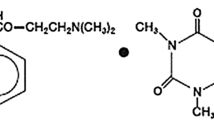Abstract
A pulsatile drug release system with a dry-coated tablet containing pentoxifylline was investigated for controlling drug release in the gastrointestinal tract. The system consisted of a core tablet with disintegrator and outer layer, which obtained compression from the ground mixtures of pentoxifylline and behenic acid. Drug release from a dry-coated tablet was investigated at 37°C in JPXII 2nd fluid at pH 6.8. The drug release from the outer layer was fitted to the Cobby model. The drug release from the wax matrix increased significantly after tablet disintegration; therefore, the drug release profiles showed typical sigmoidal curves. The disintegration time depended on the weight fraction of the core tablet, and the drug release rate after disintegration increased with increasing drug concentration in the core tablet. The relationship between the time required for 50% drug release and the disintegration time was linear, indicating that the drug release rate was controlled by regulating the disintegration time.
Similar content being viewed by others
REFERENCES
(a) T. Higuchi. Physical chemical analysis of percutaneous absorption process from creams and ointments. J. Soc. Cosmet. Chem. 11:85–97 (1960). (b) T. Higuchi. Rate of release of medicaments from ointment bases containing drugs in suspension. J. Pharm. Sci. 50:874–875 (1961).
T. Higuchi. Mechanism of sustained-action medication. Theoretical analysis of rate of release of solid drugs dispersed in solid matrices. J. Pharm. Sci. 52:1145–1150 (1963).
J. Folkman and D. M. Long. The use of silicone rubber as a carrier for prolonged drug therapy. J. Surg. Res. 4:139–142 (1964).
J. Cobby, M. Mayersohn, and G. Malker. Influence of shape factors on kinetics of drug release from matrix tablets. I. Theoretical. J. Pharm. Sci. 63:725–732 (1974).
D. R. Paul and S. K. McSpanden. Diffusional release of a solute from a polymer matrix. J. Membr. Sci. 1:33–48 (1976).
P. I. Lee. Diffusional release of a solute from polymeric matrix—Approximate analytical solutions. J. Membr. Sci. 7:255–275 (1980).
Y. W. Chien. Novel Drug Delivery Systems, Marcel Dekker, New York, 1982.
P. Buri, F. Puisieux, E. Doelker, and J. P. Benoit. Formes Pharmaceutiques Nouvelles, Lavoisier, Tec. et Doc., Paris, 1985.
R. Langer and N. A. Peppers. Chemical and physical structure of polymers as carriers for controlled release of bioactive agents: A review. Rev. Macromol. Chem. Phys. C23:61–126 (1983).
G. Courarraze, B. Leclerc, G. Conrath, F. Flson-Rieg, and F. Puisieux. Diffusion of a dispersed solute in a polymeric matrix. Int. J. Pharm. 56:197–206 (1989).
T. P. Foster and E. L. Parrott. Release of highly water-soluble medicinal compounds from inert, heterogeneous matrixes. I. Physical mixture. J. Pharm. Sci. 79:806–810 (1990).
T. P. Foster and E. L. Parrott. Release of highly water-soluble medicinal compounds from inert, heterogeneous matrixes. II. Melt. J. Pharm. Sci. 79:938–942 (1990).
S. J. H. Desai, P. Singh, A. P. Simonelli, and W. I. Higuchi. Investigation of factors influencing release of solid drug dispersed in inert matrices. III. Quantitative studies in involving the polymethylene plastic matrix. J. Pharm. Sci. 55:1230–1234 (1966).
Y. Seta, F. Higuchi, Y. Kawahara, K. Nishimura, and R. Okada. Design and preparation of captopril sustained-release dosage forms and their biopharmaceutical properties. Int. J. Pharm. 41:245–254 (1988).
J. P. Skelly and T. O. Chen. Regulatory concerns in controlled release drug product approval. Evaluation methodology of controlled release dosage forms. Proceedings of U.S.-Japan joint seminar, Tokyo, Osaka, Nov. 1988, Japan Health Science Foundation.
U. Conte, P. Colombo, A. La Manna, and A. Gazzaniga. A new ibuprofen pulsed release oral dosage form. Drug Dev. Ind. Pharm. 15:2583–2596 (1989).
R. Ishino, H. Yoshino, Y. Hirakawa, and K. Noda. Design and preparation of pulsatile release tablet as a new oral drug delivery system. Chem. Pharm. Bull. 40:3036–3041 (1992).
R. Ishino, H. Yoshino, Y. Hirakawa, and K. Noda. Absorption of diltiazem in beagle dog form pulsatile release tablet. Chem. Pharm. Bull. 40:3094–3096 (1992).
Goodman and Gilman. The Pharmacological Basis of Therapeutics, 8th ed., Pergamon Press, New York, 1990, pp. 628–630.
Merck Index, 9th ed., 1983, pp. 1025–1026.
K. Yamaoka, Y. Tanigawara, T. Nakagawa, and T. Uno. A pharmacokinetic analysis program (MULTI) for microcomputer. J. Pharmacbio-Dyn. 4:879–885 (1981).
Author information
Authors and Affiliations
Rights and permissions
About this article
Cite this article
Otsuka, M., Matsuda, Y. Controlled Drug Release of Highly Water-Soluble Pentoxifylline from Time-Limit Disintegration-Type Wax Matrix Tablets. Pharm Res 11, 351–352 (1994). https://doi.org/10.1023/A:1018944516678
Issue Date:
DOI: https://doi.org/10.1023/A:1018944516678




